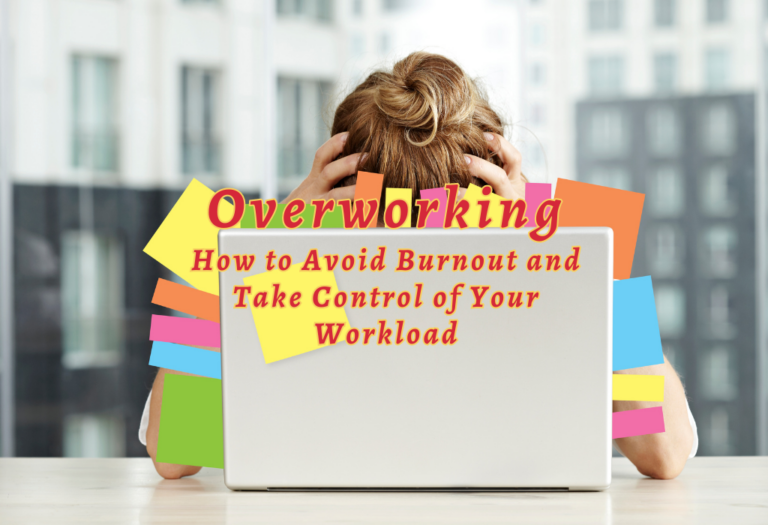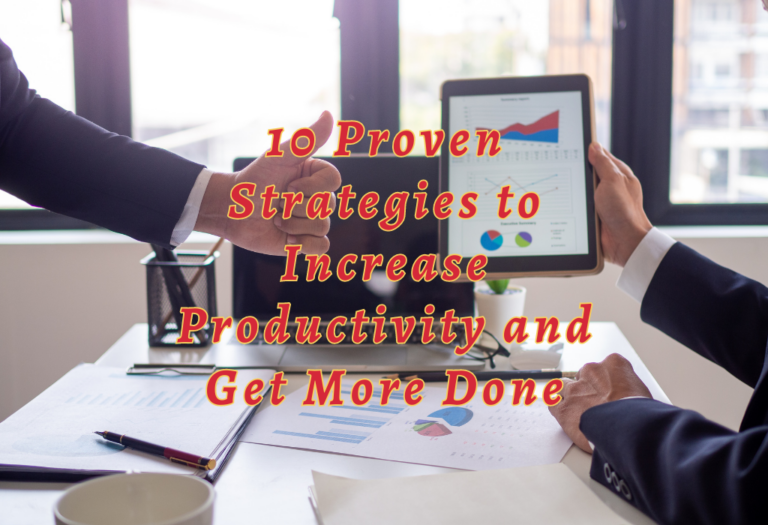Tips to Become More Productively Efficient in 2023
As the clock continues to tick and the next year draws nearer and nearer, the world is transforming and evolving, and we all need to keep up.
It’s easy to feel overwhelmed and pushed for time but there are ways to not only stay on top of the changes but potentially even stay ahead.
In this article, we’ll be focusing on 10 top tips to help become more productively efficient in 2023.

Key Question:
Making sure to manage your time well can help increase productivity and efficiency. Simple tasks such as prioritizing your tasks, setting realistic goals, and automating mundane tasks can help you become more efficient and productive.
What is Productive Efficiency?
Productive efficiency is a state, achieved when the highest level of output for a given collection of inputs is reached. It is about minimizing costs related to producing goods and services with current resources, such as capital or labor while maximizing output at the same time. To achieve this state, firms must maximize their use of inputs while doing as little waste as possible.
To put it simply, productive efficiency is when a firm produces the highest amount of output using the same inputs, or when they produce the same amount of output using fewer inputs than before. There are two main approaches to productive efficiency: technical and allocative. Technical efficiency involves producing the maximum amount of output from given inputs, while allocative efficiency refers to producing outputs optimally regarding society’s demand for those goods and services given what resources are available.
Advantages and Disadvantages of Productive Efficiency:
When discussing productive efficiency, there are both advantages and disadvantages that come with it. One argument in favor of achieving productive efficiency stresses that a business can save money by reducing waste while still achieving desired outcomes, and making the most out of their resources. However, striving for greater productivity through cost-cutting measures can also mean reducing the workforce and reducing wages an argument that critics dispute. Furthermore, if firms can reduce costs by asking workers to bear a larger proportion of these costs themselves won’t necessarily lead to increased production percentages since lower levels of employee morale could negate cost savings.
In conclusion, focusing on achieving productive efficiency means that firms may miss out on opportunities to innovate products and services and create new markets it becomes more difficult for businesses to invest in research and dvelopment or employ innovative practices when they are preoccupied with trying to maintain their current high levels of production efficiency. Productive efficiency might involve trade-offs between cost reduction and growth opportunities. In the next section, we will focus on how setting goals and making plans can help businesses make well-informed decisions about achieving this elusive state.
Setting Goals and Making a Plan:
No doubt setting goals and making a plan will make us more productively efficient in whatever tasks we are trying to achieve. Setting concrete, time-specific goals helps us prioritize what’s important, focus our attention, identify areas where we may need help, allocate resources, and track our progress. Additionally, having a plan ensures that we have contingencies should unforeseen problems arise.
Make a To-do list:
Always make sure that you’ve made a to-do list before starting any productive work this will remind you which tasks are done and which are undone this is how you can manage your time and can handle more tasks in less time.
Handle your easy tasks first:
Always start from the easy one so that you’ll complete the majority of tasks first then only difficult ones are left which would be one or maybe two so you can handle it after all of the burdens is off your shoulders.
Set realistic expectations:
When creating a plan of action toward achieving our goals, it is important to also make sure we set realistic expectations. If targets are too high or too low they might both be equally damaging if they’re too high we become discouraged by failure and if they’re too low then we won’t be sufficiently challenged to grow. Adding achievable milestones to the overall goal helps break down large projects into smaller tasks and allows us to move closer to the objective through incremental successes. To make certain that these strategic plans are realistic and attainable it’s important to review them regularly with trusted advisors who understand the organization’s needs and business operations.
Make Personal Strategy:
One size doesn’t fit all every organization requires its personalized strategy for achieving efficiency in 2023 but regardless of that strategy, setting achievable goals and creating plans of action will serve as valuable tools for success. The next section, Identifying Your Resources, will elaborate further on how to ensure that you have the personnel and technology necessary for executing your plan efficiently throughout the year ahead.
Identifying Your Resources
To maximize productivity and become more efficiently efficient in 2023, you must take the time to properly identify the resources at your disposal. This involves listing both physical and intangible resources, such as existing technology, staff or team members, your workspace, brand connections, and others. While it is easy to overlook smaller elements (like access to additional learning opportunities), their short-term or long-term impact on your productivity should also be taken into consideration. Furthermore, identifying any hardship or obstacle from early on will allow you to rethink and realign how these resources are allocated in pursuit of increased efficiency.
Cost-effectiveness
When considering each resource for maximum benefits, there are two sides to the argument: prioritize cost-effectiveness or take a long-term investment approach. Weighing out both options can be tricky since most resources involve some amount of expenditure not only in terms of money, but also human capital and other associated costs. If you opt for the former approach and focus on short-term gains through cost-cutting measures, this may not always produce optimal results over an extended period. Alternatively, if you lean towards a longer-term strategy that targets sustainable returns from incremental improvements and advances, this may prove to be even more frequently costly in the beginning but promises a higher return over time.
No matter which direction you choose to pursue when investing your resources, understanding what needs to be done when leveraging each element for maximum efficiency is crucial. That’s why it’s important to not only recognize the resources available to you but also make sure that these elements work together seamlessly so that they can make a lasting impression on your ultimate productivity levels. With that said, let’s move on to the next section: making efficient decisions.
Making Efficient Decisions
Making efficient decisions is essential for achieving higher levels of productivity and efficiency. There are several different methods for making decisions with greater effectiveness and accuracy.
Weigh the pros and cons:
One important decision-making method is to weigh the pros and cons when considering a particular decision. Taking time to consider both sides of an issue can help you make a smart and informed decision that takes into account all the facts. This approach can also enable you to gain insight into the potential consequences of your decision before taking action, allowing you to anticipate any potential risks or challenges so you can strategize accordingly.
Trust Yourself:
On the other hand, an intuitive approach may be more suitable in some cases. This involves trusting your gut feeling on a certain decision while factoring in relevant pieces of information. When you rely on intuition, it’s easy to make quick decisions as long as you learn to stay in tune with yourself and recognize when your intuitions are guiding you toward certain choices.
Take thoughtful action:
Regardless of which approach you decide is right for a given situation, it’s important to remember that no matter how small a decision may seem, taking thoughtful action will ultimately prove beneficial in the long run. Making efficient decisions requires an understanding that each choice has its own set of consequences both positive and negative that should be taken into account before moving forward.
Now let’s look at how to evaluate those advantages and drawbacks by carefully considering the pros and cons of any situation.
Main Summary Points:
Making effective decisions is critical to becoming more productive and efficient. There are two key methods for making decisions: weighing the pros and cons of the matter, or relying on intuition and trust. No matter which approach is taken, it is important to understand the consequences of each decision before taking action to make sound decisions toward productivity. Evaluating the pros and cons of any situation helps with making efficient decisions and achieving higher levels of productivity in the future.
Minimizing Distractions
When it comes to becoming more productively efficient in 2023, mastering the art of minimizing distractions is essential. Most of us suffer from the habit of multitasking, which according to research, can reduce productivity by up to 40%.
Distractions in modern society take many forms; social media applications, emails, phone notifications, and TV are just a few. To combat this temptation and stay more focused, experts recommend these tips:
1. Develop An Action Plan
Writing out your goals helps to visualize where you want to be at the end of each day and helps you become mindful about distracting tasks that don’t lead to progress.
2. Limit Social Media Usage:
Schedule specific times throughout the day for browsing through social media. Set an alert to keep yourself from getting too lost in your newsfeeds.
3. Silence Notifications:
Adjust your settings so that you only receive push notifications for urgent or important messages. Let everything else pile up and tie yourself to a specific time for dealing with them (e.g. four times during the day).
4. Organize Your Desk:
Unclutter your desk to ensure that you have all the necessary materials right there when you need them, so you don’t have to wander away looking for something while trying to get work done.
5. Create An Atmosphere Conducive To Focus:
Choose somewhere conducive to working like a coffee shop or library with little background noise and limited visual distraction and create a ‘focus area’ at home that can be used as a productive workspace (if situated away from the living room/TV area).
The notion of multitasking is being contested however; some argue that it can be beneficial under certain circumstances since most people tend to perform better when focusing on two activities simultaneously (e.g., listening and memorizing information from a lecture). So although it is generally recommended that we avoid multitasking altogether if we want to be more productively efficient in 2023, it’s important to recognize when it can be helpful – such as when listening and looking at visuals during presentations or lectures.
With all this in mind next, we’ll look further into techniques for remaining focused and defeating distraction-distress once and for all.
Techniques to Remain Focused:
One of the most important skills to cultivate to become more productively efficient in 2023 is the ability to remain focused. It’s easy to be caught up with daily distractions such as checking notifications, email, and social media. In addition, multitasking can often lead to inefficient processes and a lack of focus on important tasks. As such, here are some techniques to remain focused:
1. Take regular breaks:
One technique for remaining focused is taking regular breaks throughout the day. A break offers the chance to reassess goals and results achieved so far in that day, evaluate if additional changes are necessary, and take care of one’s physical and mental health needs. Taking a few minutes off regularly helps restore energy levels and increases focus upon returning to work tasks.
2. Say No To Longer periods of Work:
Certain theory suggests that by working longer periods continuously, either by using the Pomodoro technique (working uninterruptedly for 25 minutes followed by 5 minutes break) or eliminating traditional breaks, there is less time wasted switching between tasks which thus allows more productivity in time. While this has been effective for some people, it is still a controversial practice since it neglects essential rest hours at specific intervals which are a great aid for staying creative and productive over long-term projects.
Strategies for Increasing Motivation:
When striving for increased productivity, it is essential to keep motivation high. Utilizing effective strategies for motivating oneself and others can ensure success in achieving desired goals. When developing these strategies, it is important to consider both intrinsic and extrinsic motivation.
Intrinsic motivation:
Intrinsic motivation is internal and self-generated, arising from an individual’s interests or enjoyment of a task. Activities such as pursuing hobbies, setting personal goals, or challenging yourself with difficult tasks can help increase intrinsic motivation. Research suggests that when a person feels they are choosing something of their own accord or that they are having fun while doing something, the experience becomes more meaningful, increasing their internal drive to complete a task.
Extrinsic motivation:
Extrinsic motivation typically comes from outside sources such as rewards or recognition. This type of motivation plays an important role if someone achieves a goal due to pleasure or pain avoidance. Rewards might include anything from monetary incentives to verbal acknowledgments of success. While effective, relying solely on external forces may make someone less likely to put in effort after the reward is received.
Finding an optimal balance between both intrinsic and extrinsic motivation is key to maintaining successful productivity levels. In the end, determining what works best will depend on individual preferences and circumstances; however, understanding the available strategies can help personalize which methods fit best for each situation.
With this understanding of strategies for increasing motivation in mind, the next section will discuss some helpful productivity hacks for improving efficiency in 2023.
Productivity Hacks to Improve Efficiency
Productivity hacks can provide an easy and efficient way to improve the total efficiency. For example, the 10-minute rule suggests breaking down large tasks into ten-minute chunks for quick bursts of focused effort. Additionally, eliminating clutter can save valuable time by reducing distractions and allowing tasks to be completed faster. A “Do it now” mentality can also be beneficial in preventing procrastination and maintaining momentum throughout the day.
Technology:
Technology is another factor that should be taken into consideration when discussing productivity hacks. There are hundreds of apps available which are designed to help automate processes, remind users of upcoming tasks, and track progress. Unsurprisingly, collaboration technology can also help boost efficiency, as teams working together can often achieve more than individuals alone.
On the other hand, there may be some risks associated with relying too heavily on the use of productivity hacks and technology. Too many tools might lead to a cluttered work environment, while overly sophisticated automation capabilities have been known to create confusion during complex collaborations. It’s important to remember that while technology and productivity hack certainly have their benefits, they are not always foolproof solutions for improved efficiency.
While productivity hacks can help streamline processes and allow for more efficient task completion, balance and stress management must also play an important role in any attempt to become more productive in 2023. In the following section, we will discuss ways to maintain balance and manage stress within the workplace.
Balance and Stress Management
Having an effective balance and stress management technique is integral to becoming more productively efficient. With optimum health and a well-balanced mental state, workers will experience fewer distractions and have improved focus. When stress levels are elevated, employees may not be able to think clearly or have the ability to perform tasks as quickly.
Balancing daily routine:
One of the most important aspects of a well-rounded balance and stress management involves finding the right balance between work and daily lifestyle. Setting up a routine can help create structure and order in one’s life; however, this must be flexible enough to accommodate any changes that may arise during the day. Along with setting up a daily routine, it is also important to incorporate some downtime. Doing so will enable individuals to re-energize and get refocused on their tasks at hand.
Despite being beneficial for productivity, work cannot always be prioritized first as this could lead to overworking oneself. To avoid this consequence, staying connected with family and friends should also be the top priority. Having leisure activities like playing sports or engaging in hobbies can help keep morale high within individuals by allowing them to be surrounded by people who can bring joy into their lives beyond work.
Conclusion
Making lasting changes to become more productive is like creating any difficult, long-term project that you want to last. Starting habits can be easy, but sticking to them is much more difficult. Adopting new productive practices in the workplace needs to involve setting personal goals, utilizing the right tools and technology, engaging with colleagues and seeking their feedback, fostering creativity while avoiding distractions, and above all else, having patience and perseverance. While many of these tips may be worthwhile investments of your time, they
Follow us at Schedulemakeover.com to stay connected and learn amazing tips for your businesses! are not quick fixes. Being successful in achieving productivity requires dedication and discipline.






